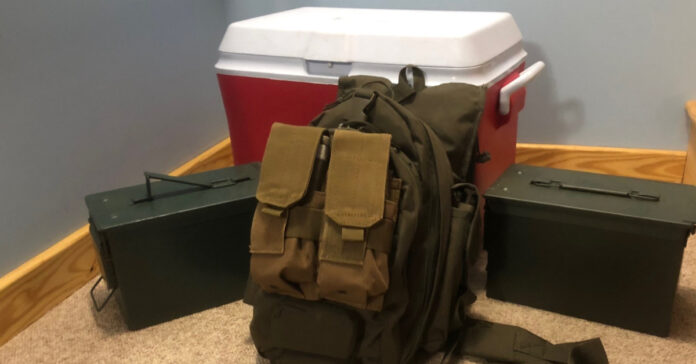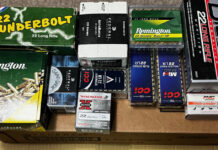
I’ve talked about creating caches before, but I’ve not yet done so. Now that it’s growing cooler, I’m making two stacks of gear and will be putting together two caches in .50 caliber ammo cans. I will hide one on our mountain property. The second will be nearby, but off our property. I’ve already selected the locations.
The purpose of the can caches is not to have supplies when we bug out, but to build on the utility of my Homestead Defense Pack. In other words, if some superior force takes over our home, the pack gives me a day or two worth of ammo and food to snipe them and cause trouble. The caches extend the length of time I can do that by a few days.
I don’t plan to bug out. I don’t expect to evacuate. If we are in a post-SHTF situation, I’ll have nowhere else to go. I sure as hell don’t want to let some uninvited folks enjoy the fruit of my labor and planning without paying a price. Maybe they’ll kill me, but I’ll do my damnedest to take some with me. I intend these caches to let me fade into the forest if we are overrun, resupply, and take out one or two of the opposition when they least suspect it. Then I will rinse and repeat, probably form another direction.
Admittedly, this might be a fantasy, but it might also be a viable plan. No way to know until I’m bolting up the mountain with a fellow prepper or two, the hoping attackers are content to have driven us away and aren’t following us.
Location, Location, Location
The first cache is going to be in a location that I plan to use as an ambush point if someone is in pursuit. It’s a spot that can’t be seen from below, and it’s unlikely anyone would stumble on the cache. I may cover the can with mud and rocks, but I don’t plan to bury it to the extent I need a shovel to recover it. I plan to hide it under what folks around here call a “camping rock,” meaning a large rock formation that sticks out far enough to protect you from the rain.
The other location is going to be much higher up and further away. We’re talking a solid two-hour hike, assuming you don’t have to stop to make sure you aren’t being followed or are not engaged in an occasional exchange of shots with the assaulters.
I don’t plan to bury it deeply. I am considering placing it under a fallen, rotten log and covering it with rotted wood residue. Alternatively, I may dig a shallow hole in which I can set the can, but the lid is close to surface level so I can grab it, tug, and keep moving. I don’t expect people will stumble upon it by walking on it because it will be because it will be in a place no one wants to walk: in the middle of a huge thicket of bushes with aggressive thorns.
Food and Ammo
Once again, ammunition will be a critical component of the caches. These are designed for defensive use, and I’m considering the best defense to be a good offense. If someone escapes with just the magazine in their gun and one in their pocket, the caches should provide rapid resupply. I’m thinking two magazines and at least 150 rounds of additional ammo for .300 blackout and the same for 5.56.
As I write this, I wonder if I should add a can at the second location. It can include .308 ammo, 9mm, .22, and some .40. Perhaps this can wait until people have bugged out here and we know what guns and calibers they are carrying. I’d hate to have .40 caliber in the box if most people are carrying .45s.
Food will be the bulk of the rest of the supplies, but by raiding my old bugout bag, I will be able to include a mess kit for cooking plus an Esbit stove with a few fuel tabs to heat water. Instead of just bars and snacks designed to keep me going on the run, this cache will have more serious food rations. I’m including one of those lifeboat ration cubes with 3,600 calories in each can. Then I will squeeze in a couple of MRE entrees and a couple packages of ramen noodles or a vacuum-sealed bag of instant rice. I would not mind sticking in a can or two of Spam.
Other Contents
I have included a spool of wire to make snares. Wire can also be used to create a tanglefoot field designed to cause a pursuer to trip. This gives the person being pursued a chance to either gain some distance or to immediately turn and shoot their pursuer.
I’m also considering including a small pistol in the second location, just in case someone has to leave the homestead without a weapon. This gives them an opportunity to get close to an occupier, such as a guard or scout, kill them, and take their long arms. (If someone has kicked us out of our prepper place and taken over, they deserve no mercy.)
Size Concerns
As you may have foreseen, as I keep adding things to the second cache, it grows in size and will no longer fit in a .50 caliber ammo can or two. I am considering using an old Igloo cooler instead. This should provide a waterproof seal and moderate temperature swings. If someone manages to spot it, they will think, “Damn kids must have been drinking on the mountain” instead of “Hey, I wonder if there’s any ammo in that can.”
The advantage of a cooler is there is more room for food, but also room for a woobie and maybe a tarp to improve our sleeping situation.
I may revert to having two can caches, each with ammo and basic food, on my property for use in emergencies. Then I’ll put the cooler in what was originally my second location. We can use that as our FOB and send patrols to raid the enemy.
Who to Tell About the Cache?
Years ago, I read an article that stressed the importance of not telling your entire team about your caches. This strikes me as good advice. I’d modify that slightly by having one location that you tell anyone who might need to run to the hills when facing an overwhelming opposing force. Then I’d have a second location that a few leaders know about, and a final location, perhaps fairly distant that only I know of. If a team member turns against me or blabs to another party about the cache, they can only spill the beans about one. In a worst-case scenario, it leaves you with one back up cache.
When caching goods, you have to be willing to potentially part with them forever. There is always the danger someone else might find and take the contents. You might forget where you put it or your mental map may have changed. Balance out this concern by thinking that if anything happens to your home, you may have nothing left but what is in your cache. For me, at least, that makes it much easier to put something in a can and hide it in the woods.







